Morocco Journal
Casablanca
We arrived in Casablanca via Paris, immersing ourselves in francophone culture via the dubious route of being resolutely ignored by elegantly dressed flight attendants. We both were absolutely exhausted by a couple of very busy weeks prior to departure, which is the correct way to fly. Being conscious during transcontinental travel does appear to be a tactical error.
We arrived in the early afternoon, arriving in time to get settled and then venture out for a short walk and dinner. Casablanca is a modern city; until 50 years ago it was a small town with nothing much to recommend it. It has now become the commercial capital of the country, with a population of 5 million and a host of rather ugly skyscrapers, and still nothing much to see. We are staying downtown in an uninspiring business hotel, chosen for convenience rather than charm. It is, however, on one of the main streets and a short walk from a main square. A very modern new tram system goes by, intimidating the taxis into stopping as nothing else could. Lining the square are cafes, all in the French style with the chairs facing out. We pick one somewhat at random and watch the world walk by.
Although most of the cafe patrons are men, there are some women. We see some women in traditional dress, long manteaux with headscarves, but others in hijab accompanied by Western clothes including tight jeans, and yet others without head covering at all. Young men in jeans and sweatshirts far outnumber the men in robes. We even see one young woman in a miniskirt and tights, although that seems outside the norm. The vendors, mostly women, sell roasted nuts and a local harissa porridge mixed with milk. The internationally ubiquitous species of "young boys playing football directly in the path of all the pedestrians" is well-represented. The temperature drops rapidly after sunset and people hurry home by the tram or bus, less likely to relax with a coffee in the cooling air. It is a busy and modern picture, and welcoming despite there being no other Westerners in evidence.

The next morning we go immediately to the one site worth seeing in Casablanca, the Hassan II mosque. This newly built mosque, completed in 1996 or so, is the 3rd largest in the world. 25,000 people can pray inside the main mosque, and another 80,000 in the plazas outside. This gigantic building is set directly on the water, near the old part of town. It has a towering square minaret that you can see for miles, and the building is so huge it is in proportion. It is only as you walk closer that the size of the entire structure really strikes you. The construction of the mosque is marvelous, as they purposefully used as much local materials and expertise as possible. The local cedar wood is displayed with gorgeous carving and painting, there are stunning mosaics, and any surface not tiled is carved in delicate plasterwork. Below the main mosque is an area for ritual ablutions and a hammam, carefully built of concrete adapted for high humidity. The building's roof can be opened to let out heat, and the gigantic minaret has an elevator and loudspeakers. It is a wonderful synergy of modern and traditional, highlighting the best of Moroccan architecture and crafts.
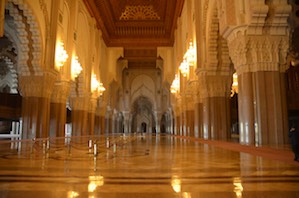
Interestingly, this is the only mosque in Morocco that we can enter. During the French protectorate, a deal was made that non-Muslims would not enter any mosques, and Muslims would not enter any bars. (The implication being that the French worship at bars, which, well....). The bar restriction has been loosened, but the no-Muslims-allowed rule holds for mosques. We are sorry to hear this, as we have enjoyed seeing at least parts of other historic mosques, but it does mean my headscarf can go blissfully unused.
Rabat
After seeing the one sight worth seeing in Casablanca, we drive up the coast to Rabat, the political capital and second city of the country. The French put their capital here at least partly to avoid the challenge of choosing between Fez (the traditionally Arab capital) and Marrakesh (the Berber capital). Prior to the protectorate, Rabat was mostly known for being the site of a Roman settlement and for its sister city, Sale, which was a pirate capital.

The Roman city was discovered by accident after the 1755 earthquake, when a 15th century mosque and mausoleum built on a rise overlooking the river turned out to have been built on a Roman settlement. It wasn't until the earthquake that the Roman site under the foundations was revealed. As a result, the current historic site has some Roman ruins emerging from a hill right next to a partially destroyed mosque and madrasa. The mosque has the characteristic square minaret found in Morocco (no rounded Turkish influence here), and there is a lovely shrine and the remains of the madrasa. The entire building seems to have been taken over by storks, who have built their nests on every remotely viable column including the top of the minaret. They dive overhead as we take photos, as though they think Roman ruins require air support.

Moving forward in history, we visit the Kasbah, a walled settlement directly overlooking the mouth of the river that separates Rabat from Sale. This was first built in the 12th century, but was later settled by refugees from the 1492 expulsion of the Moors from Al-Andalus (aka Spain). Ferdinand and Isabella pushed the Arabs, Berbers, and Jews out of Spain, and many of them crossed at Gibraltar and wound up in Morocco. There are small Jewish settlements in most of the old capitals, although much of the Jewish population moved to Israel after 1948. The Kasbah has an interesting Spanish influence, with all the buildings plastered in white and blue and some Spanish arms painted near some doors. It's interesting, we talk about the Moorish influence in Spain, and now we have the Spanish influence in Morocco. Either way, it's a lovely rabbit warren of tiny streets winding up and down hills with gorgeous blue and white plaster walls and pierced lanterns.

Another interesting mix of old and new is the Tour Hassan and the Mausoleum. The Tour was initially intended to be the minaret of a large mosque, built in the 12th century. Unfortunately the King who was building the mosque died halfway through construction, and the minaret was left only 50% done, still a very impressive but somewhat out of proportion 200 feet tall. The mosque was never finished, and the blunt partial tower remained in place for hundreds of years. Many centuries later, the current dynasty of Kings selected this site for their mausoleum, and built a mosque on the site. This does not take the place of the previously planned facility, of which only 364 columns remain, but is close enough to be able to use the partial tower as its minaret. We are unfortunately unable to see the mausoleum, as it is closed pending a visit from the current King. We don't see the King either, although we do enjoy the enhanced police presence on all the nearby streets in anticipation of his visit.
After a full day of sites both modern and archeological, we arrived at our hotel in Rabat, the elegant Villa Mandarine. This is a small hotel set in a lovely garden, with the feel of a large house. The walls are covered in prints of famous artwork, and they are kind enough to give us a guide to the prints in our room. The Picasso I could figure out, but the rest are a nice mix of old and new. We have a private terrace looking out on the gardens, and the scent of wisteria and roses fills the air. Today it is cool, but we hear the heat is coming. Tonight, though, it is time to sample the local beer (Casablanca premium lager) and enjoy the cool but delightfully scented air.
Moulay Idriss and Volubilis
Our gorgeous hotel in Rabat is the Villa Mandarine, a former private home set in a lovely garden. We enjoy freshly squeezed orange juice from their own trees as we sit amid the trees, the scent of flowers and oranges in the air. It is surprisingly cool, but the air is fresh and it's still warmer than Boston. Today we drive inland to Fez, stopping on the way at Moulay Idriss and Volubilis.

Moulay Idriss is a holy city, founded around the mausoleum and shrine to Moulay Idriss I, who is reputed to have brought Islam to Morocco. Historically, it seems that he was perhaps second to do so, but his influence is nonetheless significant. He is also the founder of one of the key dynasties of Moroccan kings, and his son Moulay Idriss II went on to found the city of Fez (or rather to make it a capital). The town dedicated to the king's memory is a lovely small city set over two hills, with a large mosque/madrasa/mausoleum in the center. There are no cars, and the streets wind up and down the hills, the riads painted white with blue or green up to waist height. Apparently the blue/green painting is relatively new, inspired by other small towns that have found this color scheme both attractive and profitable. One sight of note is the only round minaret in the country.
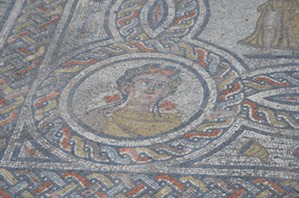
Near Moulay Idriss is the Roman city Volubilis. This was the western-most outpost of the Roman Empire in North Africa, founded around 100 BC, and abandoned (by the Romans) around 200 AD. It continued as a settlement for over a thousand years, finally abandoned around 1200 AD, and then falling into ruin after the earthquake of 1755. The ruins were rediscovered by the French and the city partially excavated about a hundred years ago, although only about half the city has been unearthed. Although they have found a couple of city gates, the basilica, a market, many houses, the baths, and a triumphal arch, they have not found an amphitheater or all of the commercial buildings one would usually expect. One thing about the Romans, they are quite reliable about their building.
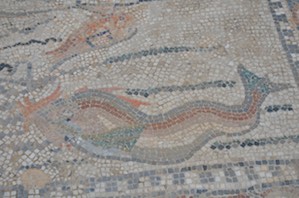
The ruins are remarkable, not for their state of preservation (which isn't great -- a lot of the marble facing was taken to construct a palace in the nearby city of Mekhnes), but for the mosaics. There are about a dozen amazingly nearly intact mosaics in their original setting in various private homes. They are just sitting there, in the open air, surrounded by low walls of tumbled stone and weeds. There's no cover, no protection aside from a little rope. They are remarkable. The figures are bright and clear, the colors intact as they used native stone rather than tile or paint. There's a scene of Hercules' 12 labors in which 10 are entirely intact. Another shows fishermen at work (helpfully labeled "Pesci" in Latin), just across from an acrobat riding a horse backwards while clutching his prize for winning a contest. My favorite was the wild beasts, including a leopard and a tiger, carrying away the heads of oryx that they had caught. The tiger's stripes are perfectly picked out in black and blue stone tiles, and the blood drips from the oryx head. We were floored (oops, bad pun) that these are just SITTING THERE, unprotected from weather, tourists, unscrupulous antiquities dealers, and grazing sheep. It's possible we have roughly 200 photos of mosaics. (Steve's note: I'll be amazed if we only have 200.). There are also some lovely columns and an okay arch. The columns are interesting mostly for being of multiple styles all in the same building, which is not typical.
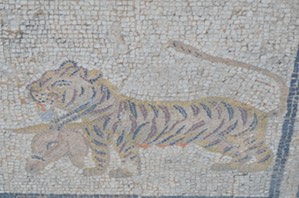
After spending far more than the budgeted time in our quest for more detailed mosaic photos (sorry...), we drove to Fez. This is one of the oldest continually inhabited cities in the world, and a center of learning since 800. It is home to Karaouine University, whose students included Avarroes and Maimonides. The medina (old city) is the best-preserved Medieval city in the world and is a UNESCO world heritage site. Our hotel tonight is described as "ugly but with an amazing view", which seems accurate. I type this sitting on the patio, looking out over the medina as the evening prayer call goes up from the many mezzuein, drinking Moroccan red "wine" and enjoying a pleasant breeze. Have a lovely evening, and all our best from Fez!
Fez
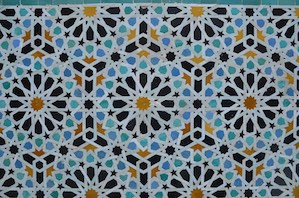
Another cool evening overlooking the Fez medina, another prayer call, but this time with Casablanca lager rather than "wine". Today we spent a lovely day exploring the city of Fez. Much of this is the medina, the old medieval city that is preserved in its wonderful maze-like glory. Almost 200,000 people live in the medina, and even they sometimes manage to get lost in the winding, unlabeled streets. There are some landmarks, the mosques and the university, but these are so hedged in by riads (large houses with a central courtyard) and stalls that you don't realize that you are near until you sort of trip over them.
Fez is also the home of artisans and crafts, many of them still done in the traditional fashion. The beautiful intricate zellije tile work is done here, each tile chiseled into shape by hand. They are fit together so tightly that you can hardly see the cement that binds them, despite the use of complicated shapes like 12-pointed stars and PowerPoint flow chart arrows. There is local pottery hand-painted in designs from the 12th century and glazed in Fez blue, as well as Hebrew styles that are based on a Star of David.
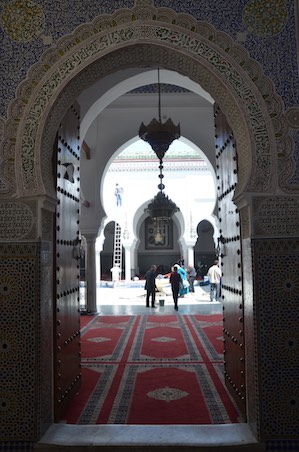
There was a large Jewish community in Fez, which by legend started over a thousand years ago when Jews from Egypt came west. Later, Sephardic Jews fleeing Andalusia in the wake of the Moorish defeat came, along with the Moors themselves, to Fez. There was an entire quarter of the increasingly-inaccurately-named "new city" (built in the 12th/13th century and ergo newer than the medina) dedicated to the Jewish population. The houses in the mellah are distinct from the riads of the medina, with balconies overlooking the street, and smaller houses built over shops or workshops. This was partially the influence of the architecture in the Andalusian cities, and partially due to the different nature of housing in this community, housing only one family rather than several generations. Much of the Jewish community emigrated to Israel after 1948, but the synagogue and even more the designs and patterns they left behind remain part of the fabric of this city.
We naturally visit a carpet workshop, which is one of the necessary stops on a tour of the medina, not least because this is probably part of how they finance tourism. We are shown hand-knotted wool carpets, woven kilims from wool and camel hair (!!), and again Sephardic designs in wool. I couldn't resist and a camel hair rug is all rolled up in a duffel, ready to come home. Hopefully it will be more cooperative in rug form than camels typically can be. Perhaps that can be my threat to the camels in the Sahara? Behave or I'll weave you?

We also see the famous tanneries of Fez, which are bizarrely closed for a few weeks in the wake of a large renovation project. These are famous for still using traditional materials, namely pigeon guano and cow urine, to tan the hides. Goat, sheep, and cow skin is brought here fresh from the hoof and is tanned and dyed in open pits. The stench is almost as famous as the resulting product. Moroccan leather was so soft and delicate that it became a byword in Europe for almost a thousand years, and it is still sold in the medina. It is a thriving trade; you can see hides being carried to auction, then dyed, then cut and worked into bags, shoes, jackets, and souvenirs. Apparently the King recently renovated the pits to improve the conditions for workers (and to reduce the runoff into the river), and they are due to reopen, still in the medina and still using pigeon guano, next week. We see a leather workshop overlooking the now empty pits, but you can just imagine what they would have looked like in use. I prefer not to imagine the smell.
The medina is overwhelming, the tiny alleys lined with stalls selling everything in the usual market districts. We walk by goldsmiths, clothing, shoes, household supplies, appliances, vegetables, butchers (with the heads of the relevant animal hung on the canopy; would you like a little camel meat?), and of course cell phones. The seafood section had a Samsung Galaxy stall directly between the sardines and the shrimp. I think it was alphabetical? There were multiple stalls selling selfie sticks (GRRRRR) and phone chargers, often right next to a stall selling handmade bone combs or something similarly ancient. Dichotomies abound. You can't really stop to take photos or shop, as there is a constant pushing stream of humanity trying to get somewhere, and every now and then you hear the cries of donkey cart drivers trying to get a delivery somewhere, and you have to leap to the walls and try to be as thin as possible. It's utter chaos, but fabulous.
One highlight for me was finding the door to the Karaouine University (filed conveniently near "hats, embroidered"), which we couldn't enter due to being non-Muslim, but we could admire as the gorgeous portal of entry to one of the world's oldest universities. Minor worshipping completed, we moved on to other, similarly disguised sites such as the mausoleum of Moulay Idriss II (son of the one from yesterday), various city gates, many gorgeous 500 year old riads with amazing zellij tiles and woodwork, and of course several mosques.
Looking down on the medina from above this evening, it remains completely opaque and a world unto itself, an experience as much as a place. It was fun to visit, but I am glad to live in a place with maps, house numbers, road signs, and absolutely no camel heads.
Tomorrow we cross the High Atlas and head toward the Sahara. Mountains! Camels (with heads)! No shopping! I'll stash the carpet, the ceramics, and the leather goods in the duffel and behave myself...
Erfoud

Today was a loooooong travel day -- 8 hours of driving. We left Fez this morning, and drove essentially due South toward the Sahara. On the way, we stopped first at the slightly hallucinogenic town of Irfane, built by the French as a ski resort. Yes, there is skiing here, and even now in April there are a few patches of snow on the grounds of the main piste. The buildings were designed to look like a ski resort, complete with alpine roofs and little balconies. The Cafe de Chamonix looks out on one of the main squares, where you can sip espresso and enjoy a croissant in the chilly morning. We did have a few minutes wondering if we had somehow gotten on our flight to Paris without noticing, but then realized that the signs were also in Arabic.

A few hours down the road, after crossing the middle Atlas and the high Atlas, we emerge in an arid plateau surrounded by sandstone hills that look a bit like Arizona. Further on, we enter the Ziz gorge, a rather Grand Canyon feel. The Ziz river runs down the center of the gorge, with a 100 yard strip of deep emerald green fields lined by date palms on either side, then the hills rise rapidly, houses clinging to their arid sides. It's stunning, the deep blue cloudless sky, the red adobe houses, the date palms, and the deep green fields. The road is wonderful, built by the French Foreign Legion and now bolstered with water mains and electrical wires from the nearby reservoir/dam.
After many hours of driving and lots of breaks for mint tea, we finally make it to Erfoud, our base for the next two nights. This is not even really a town, but rather a tourist destination with a few big hotels from which you can access the famous Erg Chhebi sand dunes. Tomorrow we head into the dunes on camel-back, but for tonight we're going to settle in with cheap beer (no more "wine", I think), BBC, and a good Kindle book or two.
Erg Chhebi
Today's episode of Top Hoof finds us in the Moroccan desert, testing two of the finest dromedaries the Northern Sahara has to offer in a unique dune test. The producers gave us each a specially-selected camel and presented us with a series of tests.
The first challenge was to mount the camel, and then (this is the critical part) to stay mounted as the camel stood. ML went first, holding onto the orange handle of the saddle, and managed to remain seated despite some significant lurching and a small but detectable squeak. Stephen went next, and really showed us all how it's done with a degree of grace rarely seen in dromedary riding. Or possibly I forgot to actually watch while his camel stood and he just told me it was amazing.

The second challenge was to ride across the Erg Chhebi dunes while performing a standard dune test. ML's camel, a cabriolet model 2731 (according to the ear tag) was clearly a sport version, with good acceleration up the hills. Stephen's camel, nicknamed (by him) Pontiac, drafted up hills and made use of the halter linking the two to do as little work as possible, being towed along by the younger, stronger, and progressively testier 2731. The ride on 2731 suffered for the extra load, and the sport suspension was clearly not a good upgrade. The sound system was broken, and the air conditioning consisted solely of a stiff breeze from the south. While there were saddles with steering handles, the dune feel was spotty at best. Things were worse in the Pontiac, however, which developed a persistent squealing noise that seemed to indicate radiator trouble.
The lack of a navigation system (aside from the lovely driver named Ahmed) led 2731 to take an unusual route along the dunes, twice turning off the track to take shortcuts downhill, which definitely degraded the driving experience. Actually, at this point it was more accurately described as a "hanging on for dear life" experience. As we were going down one of the dunes, we discovered that 2731 had severe emissions problems, making the ride in the Pontiac even more difficult given the short halter length between the two. Worse yet, the constant strain of dragging Pontiac via the tow rope seemed to cause 2731 to spring some form of leak. Clearly a fault in the camelytic converter.
After a couple of hours of intensive dune testing, we arrived on the other side of the dunes for lunch and a rest. It was time to turn them over to our expert camel driver for a timed test. Some say he lost his shirt in the housing crisis despite being a nomad, but then made it all back investing in fossils. He's not the Stig, but he is the Stig's Berber cousin! We don't have any footage of the timed lap, but we can assure you that there was spitting, and that 2731 won handily.

As for us, we grabbed a 4x4 for the return journey, and then retired to the hotel for a few hours relaxing by the pool. Our hotel has a mini golf course on the roof of the Spa (sure), which we enjoyed this afternoon. It had some interesting hazards, including a concrete dinosaur skeleton, several places where roofing material created a rough, and of course the part of the hole held down with a large rock. We found it highly entertaining, though, and even acquired an audience in the form of a bored 10 year old. Still, it was more fun than sitting in the reception area with the VERY LOUD local "band" playing their best percussion-heavy numbers. The evening found us showered and happy, sitting by the pool watching German tourists lightly baking in the sun, waiting for dinner and some more amazing mint tea.
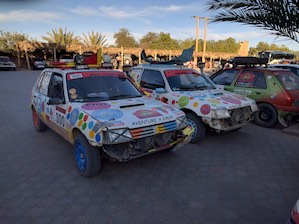
We saw a number of battered, sandy, painted cars arriving at the hotel, and it turns out there is a rally of Peugeot 205s crossing Morocco in a charity race. The drivers all look like a lot of fun; apparently it's an amateur rally, and they are all in it for the experience and to raise money. May need to hang out with them over dinner.
Todra
Last night the French rally drivers were exactly as you would imagine. They sat around the pool drinking lots of local beer while telling driving stories, then went in to dinner and had bottles of the local wine, then gathered again by the pool to swim, toast each other, and apparently sing a rather off-key song or two. I wasn't able to interpret the lyrics, but I'm going to assume that was a good thing. They scarfed down breakfast this morning and went on their way, waving and cheering as they went. Good luck, crazy Peugeot 205 drivers!

Today we left the Sahara and drove westward back toward the Atlas, stopping to enjoy the amazing Todra gorge. The Atlas are largely sandstone and limestone, with significant uplift visible in the striations on the mountains. As water flows down the sides, it carves deep gorges heading southwest. The water then travels south and west to the Atlantic, although most of the time the water dries up in the Sahara. The gorges become the home of linear oases, running some 50 to 70 km down the hills into the flatlands along the rivers.
The Todra gorge starts in the hills, and at one point the walls rise almost 200 feet above the water, and the walls are only about 20 feet apart. The walls widen (slightly) as the hills become less steep, and the valley begins. The precious flat area at the base of the gorge is used for cultivation, tiny fields of barley and other grains lined with date palms and fruit trees. The villages are in the foothills, traditional houses built in the Kasbah style that are the same reddish color as the hills. These were originally built of mud brick, but are now concrete blocks painted the appropriate red. Every couple of villages there is a mosque with a square white and red minaret rising above the village.
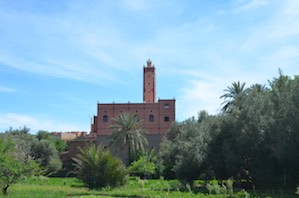
We drove as far as we could up the gorge to enjoy the narrow section, awed and a little scared by the rock climbing holds built into the walls (eep). We then enjoyed a hike down along the river and then through the fields, enjoying the quiet beauty of this pastoral scene. The irrigation channels, carefully dug by hand, are regulated by the villages so that each family has a one-hour slot, in rotation, to open their sluice gates and water their field. This comes in turn, 24/7, and is regulated only by peer pressure. The sluice gates (aka piles of rocks) and the channels reveal the level of effort put in by each family. There are still damaged areas from a flood two years ago when it rained for 3 days straight and the gorge was overwhelmed. They are still repairing, and hoping nothing so crazy happens again.
Tonight's hotel is best described as "well, they have running water and the beer's cold...", but we're safe and housed, and just finished watching the last half of Speed with Arabic subtitles and a LOT of cuts. Tomorrow, another gorge, the Dades!
Dades
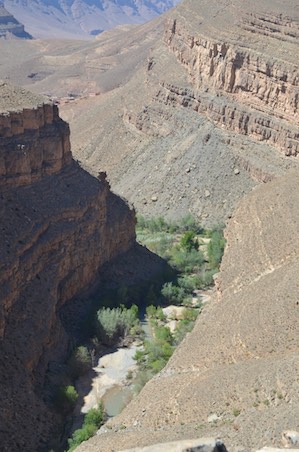
This morning we drove through the amazing Dades gorge. Similar to the Todra, this is a limestone cavern formed when the waters run down from the High Atlas down toward the Sahara, carving their way through the foothills. The Dades is known as one of the most spectacular gorges in the world (based on the ranking from Gorge Weekly? Geologists Best of 2015?). I can certainly say that the views rival those of the southwest, and we spent several happy hours driving along and stopping for more panoramic views. After a delightful lunch at yet another panoramic view, we hiked back toward the southern edge of the gorge through the foothills, villages, and fields. This valley is a little cooler and higher than the Todra, and the crops reflect that. It is known for fruit trees, vegetables, and particularly roses. The local roses are used to make rose water as well as many toiletries, and the rose festival starts in just a couple of weeks. They are just starting to bloom in the sunniest spots, but the bushes lining the fields are bursting with blossoms. You can just imagine how gorgeous it will be in two weeks. Even now, it is a lovely sight, the fields dotted with poppies and other wild flowers. Apparently this is also an area known for birding, and we pass several signs referring to the "Vallee des oiseaux". I can vouch for there being a lot of birds, including the inevitable storks, but can't really say much for the varieties. They all look brown and winged to me.
Tonight is our last night in the desert and oases. Tomorrow we drive back to Marrakesh, stopping at a number of towns on the way. This is an area popular with Moroccans for their vacations, and our hotel is full of local families enjoying the pool and the beautiful spring scenery. The television options are limited, with the only English choices being BBC World (the standard) and a KSA movie station that for some reason broadcasts all their movies with Arabic subtitles rather than overdubbing. They are having some kind of Sandra Bullock weekend, as we saw bits of Speed last night and this evening caught part of The Blind Side while we were unpacking. There's what looks like a truly amazing Bollywood film starting in an hour, advertised with a slow burn cover of Greased Lightning that was fabulous, but unfortunately it will be in Hindi. I'll make do with the soundtrack. Until then we're hanging out by the pool, enjoying the perfect cloudless sky, the 74 degree weather, and the view of red brick kasbahs, black mountains, and green fields. It's just terrible...
Ourazazate
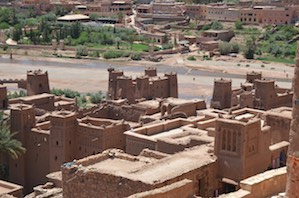
Yesterday we left the Sahara and the gorges, and drove almost 8 hours back over the High Atlas to Marrakesh. On the way we passed through Ouarzazate, the center for film in Morocco, and where large parts of high art like The Mummy and Living Daylights were created. There are two large film studios, and you can understand why. There's a combination of snow-covered mountains, desert plains, clear blue skies, and cheap local labor that makes it somewhat irresistible for location shoots. We also stopped at a well-preserved fortified city and trading post called Ait Ben Haddou, a UNESCO world heritage site which features prominently in the film Gladiator and apparently one of the seasons of Game of Thrones. This is rather like a desert-based Mont St Michel, a lovely hill town with well-preserved kasbahs and only a light layer of opportunistic vendors. After some time wandering around the site listening to Steve making plans to fool tourists with phrases like "this cat, by the way, was adopted by Russell Crowe while he was here", we moved on into the mountains.

The road over the pass is amazing, quite a feat of engineering by the French Protectorate, and a fabulous driving road much like the best Alpine passes. We climbed (and then dropped) almost 6000 feet on a two-lane road that consisted of little but switchbacks. Apparently both Top Gear and the Amazon-show-with-Clarkson-Hammond-and-May were filming in Morocco recently, and I'm sure one or both teams were on this road. It is stunning, and the views are just beautiful. There are road works underway, so parts didn't have guardrails so much as little piles of stones, but our driver was raised in the High Atlas and laughs at heights. Not literally, that would be weird.

We arrived in Marrakesh late, really with time just to unpack and head to dinner. Fortunately our hotel was the amazing La Maison Arabe. This riad opened in the 1920s as a restaurant, initially owned by two French women who were living in Marrakesh. It served all the notable expats, including Winston Churchill who frequented it during his many stays in the city. They opened a cooking school and the restaurant became the center of modern Moroccan cuisine. In the 1990s an Italian businessman bought the property and decided to open a hotel, the first of the riad hotels in the country. It has expanded to take over 5 houses, and now has 26 rooms, 2 dining rooms, a hammam, and a small swimming pool (that becomes a water feature for one of the restaurants after dark). They also have their own farm outside the city that sources much of the food used in the restaurants. The restaurants clearly remain the star attraction, but the rooms are lovely and luxurious, each unique and special. Ours looked out over the swimming pool/restaurant #2. It also was about a block away from the famed Koutoubia minaret, which became quite obvious when the call for prayer went up during our dinner. La Maison Arabe is known for its cellar of local wines, and I was initially dubious given my experience in Fez. Trusting to the best restaurant in the country, I tried a local Shiraz. I stand corrected, and quite happily so. I won't be seeking out Moroccan wine in the States, but at least I know what to order! It was amazing to be pampered with a nice room, warm (but not desert hot) breezes, an excellent dinner, and a short walk upstairs to head to sleep with no bugs. I'm afraid that after our desert sojourn I'm rather splotchy with sunburn and have a number of mosquito-related injuries, so it's not the most salubrious sight when I dress for dinner despite my efforts.
Essaouria
Our morning started early with the call to pre-sunrise prayer, about an hour before our alarm clock was due to go off. When they describe the hotel as having an excellent location right near the center of the Medina, that is certainly true, but does come with some downside! We'll have to enjoy the good parts later, as we aren't staying to enjoy Marrakesh just now, this is just an overnight stop. I was only convinced to leave our oasis of excellent food and constantly available mint tea by the lure of Essaouria. Fortunately we will be back in a couple of days, otherwise Steve might have had to resort to extreme measures.
Essaouria is a small city on the Atlantic coast about 3 hours due West from Marrakesh. It was initially founded by the Phoenicians, then was famous under the Roman Empire for the purple dye created from the local shellfish. This created the imperial purple used in the Roman robes, and was transited from the coast through Volubilis to Rome. The local viceroy, Juba II, was in fact killed when he arrived in Rome in a fully purple robe, thus wearing more purple than the Emperor. The demand for purple dye waned, and the city became rather obscure until about 1750 when the Sultan of Morocco decided to fortify a port in this location. It was later taken over by the Portuguese, and the Spanish, and the French. It remained a small port and fishing town, not really a destination of the desert caravans (they went to Marrakesh). Even today the population is less than 100,000 and it's a bit of a backwater.
There is a local tree called Argan that is cultivated for the oil of its nuts, similar to olive oil, that is used both for cosmetic and culinary purposes. Apparently Argan doesn't grow anywhere else but in this unique combination of humidity, sandy soil, and temperate climate. Classically, the Argan nuts are eaten by goats, who climb the short scrubby trees (they look a bit like olives). (The trees, not the goats.) (Well, some of the goats a bit, too, from a distance.) The goats then...errr...process the nuts in their digestive system and the resulting de-hulled nuts are harvested from their droppings by the local women. They then further de-hull the nuts to reveal an almond-like center. This is ground to produce the oil. The oil is both used similar to olive oil in salads and to dress vegetables, and as a skin/hair treatment. It is sold as Moroccan oil around the world, so if that sounds familiar, try not to think of the goats. Argan oil is one major industry around here other than fishing.
The third local industry is hippies. In the 1960s, Jimi Hendrix visited here for a week, and the locals now believe he was here for a year and have turned this into a local legend. Other famous musicians stayed here, drawn by the temperate weather, the laid-back atmosphere, and the gorgeous sunny days. The constant wind means that you have the feel of a beach town but with a high temperature of about 74 even in the hottest part of the summer; it's amazing. You can't really swim in the ocean despite the beaches, as there are rip tides, but people make up for that with surfing, kitesurfing, and sailing. Today the small but beautiful medina is a draw for European tourists and backpackers, with a relaxed attitude and a love of artists of all kinds. There are many painters who call this city home, and there are art galleries filled with funky modern African/Arab art. There are film and music festivals, and lots of rooftop bars with bands where you can watch the sun set over the ocean and enjoy a drink and a dance. (Apparently there's also a part of town famous for its marijuana, which seems odd in a country where citizens can't even buy beer legally.). The souk is for both locals and tourists, but is unique in that there is no hard selling; the proprietors just wait for you to come to them. It's perfect for strolling and relaxing.
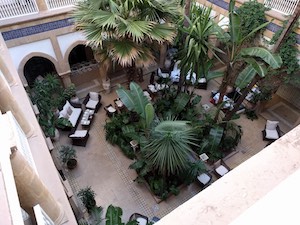
We are here for 2 days of relaxation, staying in the beautiful L'Heure Bleue, a riad hotel just inside the medina. When we arrived, we walked up to a blue door in an anonymous white wall marked only by a little sign, rang the doorbell, and were welcomed into a gorgeous historic riad. The courtyard is an oasis of palms and fragrant vines, and our room is scented with incense and designed with local zellij tiles and dark carved wood. As soon as you pass through the door, the chaos of the medina and the souks outside is left behind and all you can hear is the water in the fountain and the chirping of the birds. They also have an amazing restaurant and a hammam...this vacation is looking better by the minute.
We wandered the town this afternoon just enough to enjoy the combination of beach town and historic medina that draws people to the seaside. Then we decided to do what everyone does here and just chill. I write this from the courtyard, enjoying a Kir (local white wine isn't so bad either, it turns out) and actually just a touch chilly in this perfect hour after sunset, L'Heure Bleue.
Today was Marathon Monday in Boston, and it's hard not to reflect back to three years ago, particularly since this is the first year since that time I haven't been on service. We hear it was just as it should be -- uneventful, with women screaming in Wellesley, cheering at Heartbreak Hill, and lots of happy people making their painful way down Boylston. We raise a glass in your direction over the waves.
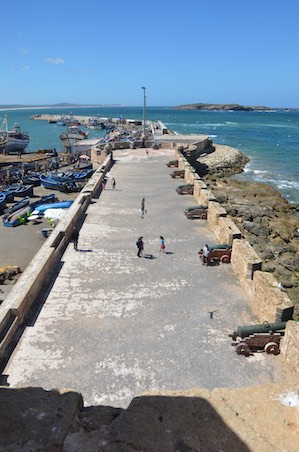
We spent another lovely day in Essaouria, wandering around the city. The old city walls, created variously by the Portuguese, Spanish, and French, are still in place as are the cannon that defended them. These are helpfully labeled with suits of arms and the year they were cast, so you can keep track of the various changes in ownership. It's useful that they simply recycled cannon rather than recasting them. One end of the fortress-like walls (aka the Skala) is right next to the harbor/fish market, which provides both an overpowering aroma and a large number of gulls, adding to the atmosphere. At one point the gulls started to surround us and we feared a Hitchcockian scene (or at least a need for laundry). We didn't stay near the market, but rather wandered down the beach to watch the kite surfers crashing, then came back to town to enjoy a lunch of mint tea and crepes.
In the afternoon, I decided to indulge in a hammam. The hammam tradition is strong in Morocco, a leftover from Roman times with the three main rooms (tepidarium, cauldarium, frigidarium) intact. Public hammam are found everywhere, and people in the cities visit once or twice a week for a good gommage (exfoliation/scrub down) with black soap, a nice hot steam, and perhaps a massage. I indulged in the same, but in the privacy of the hotel. It's fortunate I speak a little French, as the ladies of the hammam definitely didn't speak English. Without my glasses and with a lot of steam, there was no way gestures were going to work! The nice lady avoided exfoliating my sunburned patches ("soleil?!?") and instead rubbed in a ton of Argan oil scented with orange flowers. Afterward, I felt not only very buttery, but also very relaxed and smelled probably better than at any previous point in my life. I kept asking Steve to smell me, which could be misinterpreted.
One challenge of the hammam culture is that all showers in this country seem to be handheld. As they clearly don't expect some foolish person to stand there under the stream of water, they are pretty much always mounted nice and low, for easy reach. Sometimes there's a way to raise the holder, but more often this is fixed, aimed directly at one's lower torso. Not convenient if you want to wash more than 60% of your body, which I dare to do. The shower in Marrakech was over a tub with a separate seat, at which the shower head was of course aimed so you could easily sit and have the warm water wash over you. Lovely if you like that sort of thing, but if you wanted to have a traditional shower you wind up looking like Captain Morgan, one foot on the seat, one in the tub, sort of limboing so you can get your hair wet. It's a graceful look. I eventually just gave in and sat down. These guys have been making bathing an art for about 2000 years, so who am I to question?
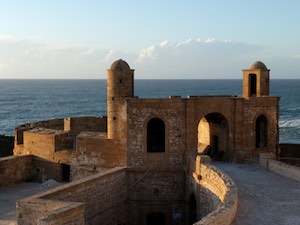
For dinner we went to an interesting Moroccan/Italian restaurant with their own wood fire oven for pizza, but more to the point the best view in the city. We avoided the pizza, but enjoyed sitting on the balcony overlooking the city wall and watching the sunset. Stunning. Since all the buildings are much taller than the wall (which does rather seem to obviate the wall's purpose...), the view was wonderful.
Marrakesh
After two lovely days, we woke early for the drive back to Marrakesh. We had enjoyed the calm, breezy, relaxing atmosphere of Essaouira so much it was hard to leave, but the city was small enough we had pretty much seen all of it twice by the time we left. Marrakesh is a very different animal, a large city of over a million people, comparable in size to Fez, and one of the key historic capitals of the country. The capital of Morocco kept switching between Marrakesh and Fez, and you get the idea that each successive dynasty felt obliged to make their capital the BEST, the most ornate, the most expansive, and the best decorated. Mosques, universities, and souks were left intact, but palaces were torn down and rebuilt, often plundered for parts.

The medina of Marrakesh is newer than that of Fez by several hundred years, dating to the 1100-1200 period rather than 800s. The souk in particular is laid out in a grid pattern and has a number of safety features, including areas that would be sealed up at night with no one allowed inside to prevent theft and fire, multiple separating doors (much like modern fire doors), innumerable fountains, and perhaps most impressive an extensive 1100 sewer system that has been in continual use (with upgrades). There are the usual sections -- leather working, wood working, brass lanterns, pottery, rugs, clothing, meats, fruits and vegetables, nuts and dates, household appliances, stupid tourist souvenirs, and of course tagines. We are guided by an expert who leads us not just down the main, large streets, but also to the back alleys where the work is actually done. I avoid being soldered, dyed, or sewn, but it's a close thing. The alleys are all covered, so it is cool and a bit dark inside, and there are many fountains and squares. The squares are key, as you cannot stop in front of anyone's stall without inviting a sales pitch. They are used for auctions during the day, each square with a particular speciality. People who do not rent stalls can come in, auction off their rug/donkey/lantern and then spend the proceeds on their way out. There are modern concessions in this temple to mercantilism; there are signs for the way out mounted overhead, and there are 3 ATMs incongruously placed very near the carpet section. You are walking through the Middle Ages and suddenly there's a Societe Generale ATM with a big sign overhead. It was odd, but in keeping with the spirit of the souk.
We also visited the much calmer Majorelle gardens, in the Ville Nouvelle (French part of town). This is a botanical garden created by French artist Jacques Majorelle and his friends, and later kept up by Yves Saint Laurent, the French designer who lived in a villa here next to the gardens. There is a memorial to Saint Laurent in the gardens, and there will soon be a museum to his work next door. The gardens are interesting, with three main sections -- palm trees and their associated underbrush, cacti from around the world, and bamboo. Plants aren't really labeled, although there are some half-hearted signs occasionally. There is a bright blue villa at one end of the gardens, and a lovely fountain with a lotus pond running through the middle. For lack of accurate information, I attempted to narrate the garden tour on my own, but Steve seemed to think that "succulenta bulbiform" wasn't a real plant and vetoed my artistic commentary entirely. Heathen.

For our first night in Marrakech, we opted to eat at a restaurant overlooking the crazy square in the center of the medina, the Jemaa el Fna. This square (well, really, entirely irregular polygon) is like Times Square if it were three times as large and had snake charmers. It is active all day long, from the morning when the jus d'orange stands do booming business, to mid-day when the souvenir stalls, henna-painting women, and snake charmers move in, to evening when 200 grilling food stalls show up. All day people come through on their way between the souks (which surround the square on 3-ish sides) and the main mosque (which is on the 4th side).
The Koutubia minaret, built in the 1200s and still the tallest building in town at 77 meters, looks down on the chaos. This lovely structure was the model for the minaret in Grenada and the partially-completed Tour Hassan in Rabat. It follows the ideal 1:5 proportions (5 times as tall as it is wide), and has different window decorations on each side. An interior ramp leads up the many stories to the top, from which the mezzuein would call the people to prayer. These days there are loudspeakers to do this, but the ramp apparently remains. The tower was originally clad in stone, but is now left with the brick underlayer exposed, only a border of green and while tile at the top. As we dined, we watched the sun come down over the minaret and the square. We then walked back to the hotel on the non-snake-charmer route.
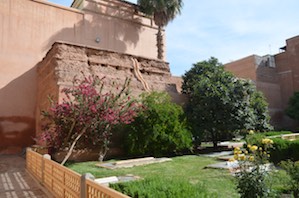
Our last day in Morocco we started with a horse carriage ride through the edges of the Ville Nouvelle and around the palaces on the edge of the Medina. Unlike some other cities in the country, Marrakech has many public gardens and a greenband. We then visited the Saadian tombs. These date to the late 1500s, comparatively new for our travels. The king at the time built these tombs for his family and key retainers, just outside a large mosque. The next dynasty did not destroy the graves, but rather walled them up and they were duly ignored. In 1917, the French "discovered" this complex, although it begs credulity that the residents were not aware of a rather large gap in their neighborhood. The shrines are gorgeously decorated and surrounded by a garden. Perhaps due to their long abandonment, the tile and other decorations are bright and almost untouched. They are refined and more delicate than the older (more frequently repaired) versions seen on some of the other buildings, and the bold colors are delightful in the shaded cool of the shrines.
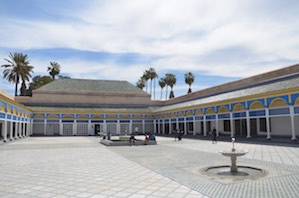
Continuing the palace theme, we then turned to the Bahia palace, which is open to the public as it is no longer used by the royal family. Apparently it was so pretty the French decided to "borrow" it for the use of their official guests and staff, and after the protectorate ended the king chose not to retake it. It is now a museum, restored and during our visit hosting an art exhibition. It was built in the late 19th century and was intended to show off to the world the essence of Moroccan artistry and gentle living. The best craftsmen toiled for years painting, carving, tiling, and gardening to create a jewel box palace that seems to define Oriental luxury. The perfectly symmetric and carefully cultivated gardens wth elaborate fountains are a reminder of the importance of these outside reception rooms in Arabic culture. Our other stops to other riads and museums paled by comparison, although it is encouraging how many museums of Berber artistry and culture are being developed to capture this unique population.
We enjoyed a final dinner in our riad, enjoying the music, the call to prayer, the fabulous food, and the patterns cast by the pierced lanterns overhead. The lasting impression of this country is of a commitment to making even simple things beautiful, with a refinement of the standards of Islamic art. There is also the steadfast uniqueness of the Berber community, quite clearly NOT Arab, standing aside and proud of their traditions. Underpinning it all is the long history of Jewish settlement, dating back thousands of years, integral with the Berber community in particular, the founders and keepers of so many of the crafts that are still practiced by hand today. Add to this the spice of the Andalusian refugees, and overlay with a soupçon of French culture...it's a heady mix. There is a deep commitment to Islam, witness the national drink being not wine (fortunately) nor beer but rather jus d'orange. At the same time there is a love and embrace of others, a deep-seated tolerance, and a welcome of visitors, even the crazy German ones wearing shorts and halter tops as they browse for purses. There is tremendous natural beauty, and the surprise of snow-topped mountains next to the great Sahara desert. Despite a stable monarchy that weathered the Arab Spring with no problems and a quest for open debate, tourism is down, and the economy is down with it. It is regrettable; more should experience this lovely place.